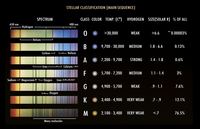
Photo from wikipedia
Aims. The physics driving features such as breaks observed in galaxy surface brightness (SB) profiles remains contentious. Here, we assess the importance of stellar radial motions in shaping their characteristics.… Click to show full abstract
Aims. The physics driving features such as breaks observed in galaxy surface brightness (SB) profiles remains contentious. Here, we assess the importance of stellar radial motions in shaping their characteristics. Methods. We use the simulated Milky Way-mass cosmological discs from the Ramses Disc Environment Study (RaDES) to characterise the radial redistribution of stars in galaxies displaying type-I (pure exponentials), II (downbending), and III (upbending) SB profiles. We compare radial profiles of the mass fractions and the velocity dispersions of different sub-populations of stars according to their birth and current location. Results. Radial redistribution of stars is important in all galaxies regardless of their light profiles. Type-II breaks seem to be a consequence of the combined effects of outward-moving and accreted stars. The former produce shallower inner profiles (lack of stars in the inner disc) and accumulate material around the break radius and beyond, strengthening the break; the latter can weaken or even convert the break into a pure exponential. Further accretion from satellites can concentrate material in the outermost parts, leading to type-III breaks that can coexist with type-II breaks, but situated further out. Type-III galaxies would be the result of an important radial redistribution of material throughout the entire disc, as well as a concentration of accreted material in the outskirts. In addition, type-III galaxies display the most efficient radial redistribution and the largest number of accreted stars, followed by type-I and II systems, suggesting that type-I galaxies may be an intermediate case between types-II and III. In general, the velocity dispersion profiles of all galaxies tend to flatten or even increase around the locations where the breaks are found. The age and metallicity profiles are also affected, exhibiting different inner gradients depending on their SB profile, being steeper in the case of type-II systems (as found observationally). The steep type-II profiles might be inherent to their formation rather than acquired via radial redistribution.
Journal Title: Astronomy and Astrophysics
Year Published: 2017
Link to full text (if available)
Share on Social Media: Sign Up to like & get
recommendations!